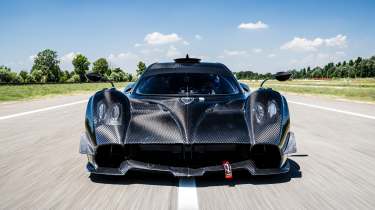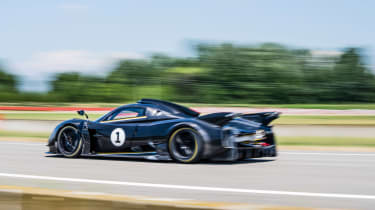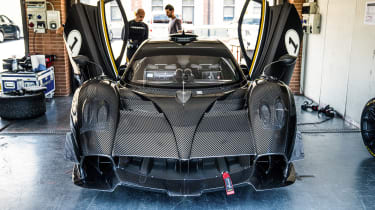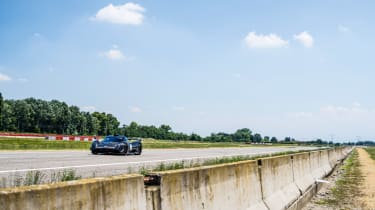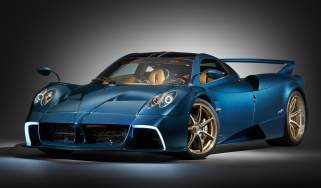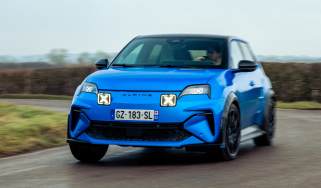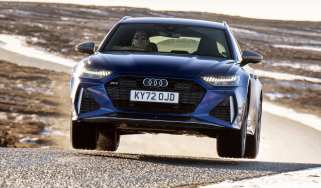Pagani Huayra R goes testing on video: behind the scenes
Looking glorious in unpainted carbonfibre and boasting an all-new, 838bhp naturally aspirated V12 engine, Pagani’s track-only Huayra R goes testing
'It’s a sweltering day at the Vairano test track just south of Milan and the pit garages are empty save for one. Inside it’s a hive of activity, with mechanics swarming around the rear of a car up on air jacks, bare carbonfibre bodywork removed and baking on a stand in the sun in the paddock behind. Next to the exposed car are a row of engineers and a bank of laptops. The atmosphere is tense but excited. The prototype track-only Pagani Huayra R is ready for shakedown and aero tests.
Just 30 Huayra Rs will be made and the price of entry is €2.6million plus taxes (let’s call it £2.7million), so it is the very definition of a ‘toy’, but the engineering behind it is serious and the mechanical make-up fascinating. The chassis is all-new and built to pass FIA standards without the addition of a roll-cage, while nestled in the back is a brand new and bespoke 6-litre V12 engine built by HWA AG. If you’re not familiar with HWA then you can rest assured Pagani’s strong connection with Mercedes continues. Back in 1999 when AMG was bought by Mercedes, HWA was created to handle racing activities and the HWA Team has since handled Le Mans, DTM and Formula E activities. It’s named after founder Hans-Werner Aufrecht, who also started AMG back in 1967 with Erhard Melcher.
> GMA T.50s Niki Lauda track-only supercar revealed
Creating a new, naturally aspirated V12 producing 838bhp at 8250rpm and 555lb ft from 5500 to 8300rpm and running on to 9000rpm for a production run of just 30 cars seems extraordinary and unlikely, but Francesco Perini (manager of concept, composite and mechanical design) insists that’s what they’ve done. ‘Unlike the Zonda R, which used a derivative of the CLK GTR engine, the Huayra benefits from our all new V12-R engine,’ he says.
The dry-sumped, direct-injection V12 connects directly to the carbon monocoque and is a stressed member of the chassis, supporting a six-speed sequential dog-ring gearbox, plus the chrome-molybdenum subframe for the double-wishbone suspension. Dampers are by Tractive and the entire suspension system previews the set-up we’ll see on the replacement for the Huayra road car, currently known only as the C10.
‘Our customers demanded a naturally aspirated engine,’ Perini continues. ‘Plus, Mr Pagani was determined that the car should capture the energy and excitement of sports-prototype racers of Le Mans [his favourite is the Porsche 917] and the pure noise of F1 cars from the 1980s. We think this engine delivers.’ The V12-R engine weighs 198kg in total, the ’box is another 80kg and all-up the Huayra R is 1050kg (dry). Despite the extraordinary 140bhp per litre and the lofty rev limit, the V12-R has service intervals of 10,000km.
Flow-viz paint is sprayed on various surfaces once the rear bodywork is attached and the gorgeous Inconel 625/718 alloy exhaust system is hidden away, then everyone stands back as the high-pitched starter motor spins for a few seconds before the V12-R engine bursts into life. Predictably enough, it sounds outrageously good. Idle is fast and angry and sounds every inch the racer you’d expect, and as the R exits the pit garage and heads out into the brilliant sunshine it has the complex, piercing note that only a 12-cylinder engine can produce. Today is just a straight-line test, but within seconds the noises reverberating around the facility make it sound like a whole grid of cars are on their warm-up laps.
It’s our first look at the Huayra R fully dressed and out in the light, too. Pagani is nervous about us photographing certain details – anything on the interior, including the fixed seats built into the monocoque – because the prototype is not quite up to the usual finished Pagani standards. Even so, the bare carbon is perfectly matched, with a central spine running the length of the car where the weave meets, the engine bay looks simply gorgeous and the interior might not be perfectly trimmed but the layout and structure is clearly going to be very special, too.
The Huayra R is a stunning looking device and has a strong retro element to it – part race-car, part art deco wall art, part Batmobile best sums it up. However, the aero performance is powerful and today is all about corroborating the CFD and wind tunnel work – much of which was undertaken at Dallara, one of the technical partners for the R project. Pagani is targeting 1000kg at 199mph (by comparison a Senna GTR makes 1000kg at 155mph), although its simulations suggest recent tweaks to the design have exceeded this number.
After the first few runs, the real data seems even better than they’d hoped. ‘The key,’ says Perini, ‘is to make the aero platform as stable as possible. We could produce much, much more downforce with a lower ride height but the drop-off in performance should the car bottom out, or hit big kerbs, is not acceptable to us. We want our customers to feel confident and for the car to look after them.’
Later in the evening the results come directly to Mr Pagani and I happen to be there. His face lights up. ‘Andrea Palma reports the car is fantastic immediately,' he says. 'And the numbers are very encouraging... over 1200kg of downforce. Plus, it is very easy to drive.'
There is still much more to test - the performance of the latest CCM-R brakes and 19-inch Pirelli slick tyres (built to a standard racing size so that the R will always benefit from Pirelli's latest motorsport learnings) plus the optimisation of suspension, the Bosch motorsport traction control and ABS settings and various other systems. It's fascinating to see the intensity of the development programme for a car that will be built in such tiny numbers. It makes you wonder what the V12-R engine will fit into next...
Sadly it won't be homologated for the road but I suspect there are many more projects from Pagani to come that will scream to 9000rpm.
Pagani Huayra R specifications
| Engine | 6-litre naturally-aspirated V12, 9200rpm redline |
| Max power | 838bhp @ 8250rpm |
| Max torque | 553lb ft @ 5500 - 8300rpm |
| Transmission | Six-speed sequential |
| Suspension | Independent double wishbone with helical springs and electronically controlled active shock absorbers |
| Brakes | Brembo CCM-R carbon ceramic discs; 410mm front, 390mm rear, six-piston calipers front and rear |
| Wheels | APP Tech, 19-inch front and rear |
| Tyres | Pirelli P Zero slicks, front 275/675 R19, rear 325/705 R19 |
| Weight (dry) | 1050kg |
| Power-to-weight | 798bhp/ton |
| Basic price | £2.7m |

